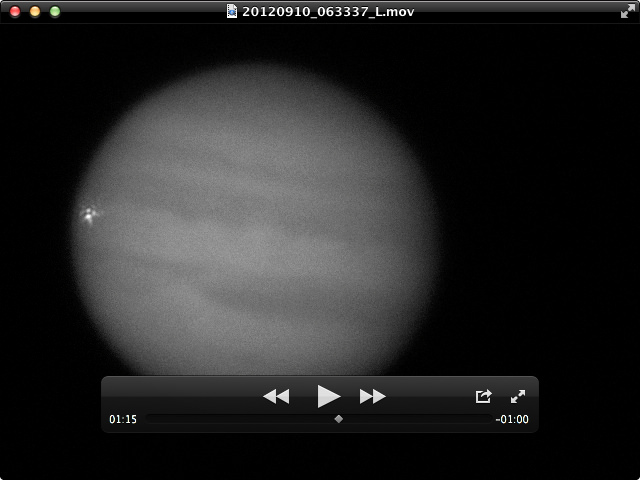An apparent object impact captured about 6:35 am on Sept. 10, 2012 from Dallas, Texas USA. Credit: George Hall.
UPDATE: Yes, there was an impact! An amateur astronomer in Dallas Texas, George Hall captured the impact flash in his webcam — click here to see his website and image — at about 6:30 am on Sept. 10, 2012.
——-
From astronomer Heidi Hammel of the Space Science Institute comes news about a potential new impact on Jupiter. She reports there has been a visual sighting of an apparent fireball on Jupiter earlier today (about 10 hours ago, as of this posting) so the impact site should be visible again over the next few hours. According to amateur astronomers discussing this on G+, the impact area on Jupiter won’t be visible again until about 05:00 UTC, (01:00 EDT). The amateur who observed the flash was Dan Petersen, from Oregon, who made the observation at approximately 11:35 UTC on September 10. Petersen reported it to Richard Schmude of the Association of Lunar and Planetary Observers (ALPO). Hammel says the report sounds realistic, but obviously it needs confirmation if possible: a) by looking for any ‘impact scar’ tonight or over the next few days; b) by searching any webcam video that any observers might have been recording at the time. From the time and position given, the flash was on the North Equatorial Belt at approximately L1=335, L2=219, L3=257. “Let’s hope someone has a record of it!” Hammel says.
If it was the impact was sizable enough, it might have left an impact scar like those seen after the Shoemaker-Levy/9 impacts and this one in 2010:

Anthony Wesley from Australia captured the flash of an impact in June 3, 2010. There was also a similar impact and flash in later in 2010 and a big one in 2009.
On the Cloudy Nights astronomy forum, Petersen described his sighting:
This morning (9/10/2012) at 11:35:30 UT, I observed a bright white two second long explosion just inside Jupiter’s eastern limb, located at about Longitude 1 = 335, and Latitude = + 12 degrees north, inside the southern edge of the NEB. This flash appeared to be about 100 miles in diameter. I used my Meade 12″ LX200 GPS telescope and a binoviewer working at 400X for the observation, seeing was very good at the time. I was thinking about imaging Jupiter this morning but decided to observe it instead, had I been imaging I’m sure I would have missed it between adjusting webcam settings and focusing each avi. We’ll have to wait and see if a dark spot develops inside the southern regions of the NEB over the next day or two. Good luck imaging this. My best guess is that it was a small undetected comet that is now history, hopefully it will sign its name on Jupiter’s cloud tops.
If you make any observations or find you have webcam footage that may show such an impact, please send us an email.
Via astronomer Pete Lawrence (@Avertedvision on Twitter) is a simulated view showing where impact may have occurred (X marks the spot).
We’ll provide more updates as they become available.



THANK YOU Jupiter! I hope there’s some ‘bruising’ apparent….
SpaceWeather.com has impact images this morning… I wonder if there’s a way to tell whether it was a comet or an asteroid? Maybe? pre impact images will show the interloper?
Anthony Wesley’s above image indicates the impact came from what angle? An inside Jupiter orbital path? The SpaceWeather image by George Hall shows a different Latitude for the impactor? Maybe there was more than one?
Jupiter imaged a few minutes ago: http://goo.gl/wurvr
This is the last
image I took of Jupiter just before dawn – the impact area is just coming into view: http://goo.gl/T71bI
Time of the image is
05:52UTC (10:50PM PDT).
It seems the flash happened near the western limb not eastern, am I right ?
I’m sorry, I’m a bit of a novice here, but if Jupiter is a gaseous planet, why would there be impact scars?
Basically, when a low density asteroid or comet enters a planet’s atmosphere, ram pressure will cause the object to break up and explode at high altitude; the resulting explosion is like a nuclear detonation that rises up in a mushroom cloud carrying debris and what-have-you into the planet’s upper atmosphere where it appears as a sooty scar.
Plasma discharge, perhaps…
Just a quick comparision of the size. Blast vs Jupiter vs Earth.
http://img12.imageshack.us/img12/4585/jupiterv.jpg
Looks for me like an another dinosaur_extinction size. It is good to have such a shield somewhere in space…
Sadly this “shield” can deflect many asteroids directly to Earth, that had no intention to come by us, but had the badluck to fly to close to Jupiter…
Not much of a shield – in comparison to its entire orbit Jupiter is teeny-tiny.
I’ll be providing
live images of Jupiter on the slooh.com homepage from 7:00 PM PDT ¦ 10:00 PM
EDT ¦ 02:00UTC on Tuesday. International times
here: http://goo.gl/YydNQ
We’ll be hunting for signs of the impact until dawn.
slow motion video from Jupiter impact: http://www.qicknews.de/Forum/viewtopic.php?f=4&t=231&p=2114#p2114
As soon as we heard the news, we pointed the telescopes at Jupiter for the following 48hrs. I’ve just finished a Jupiter time-lapse from last night (http://goo.gl/CNoiv) – absolutely no sign of any impact soot from Monday’s comet or asteroid hit.